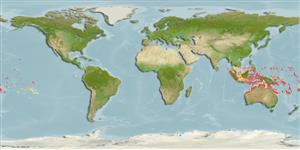Common names from other countries
>
Gobiiformes (Gobies) >
Gobiidae (Gobies) > Gobiinae
Etymology: Eviota: No etymology given, suggested by Christopher Scharpt: from Latin 'eu' for 'true' and 'iota' for anything very small, in combination 'truly very small' referring to it as being the smallest vertebrate at the time it has benn described by Jenkins (thus, making the suggestion by Scharpt plausible..
More on authors: Jordan & Seale.
Environment: milieu / climate zone / depth range / distribution range
Ökologie
seewasser riff-verbunden; tiefenbereich 1 - 30 m (Ref. 86942). Tropical; 10°N - 23°S
Western Pacific: Vietnam, Indonesia (Moluccas), east and northward to Japan (Ryukyu Islands); east through Micronesia (Palau, Guam, Federated States of Micronesia [Yap], Kiribati [Gilbert Islands]); including New Caledonia, Samoa, and French Polynesia; south through Melanesia to Australia (Great Barrier Reef).
Size / Gewicht / Alter
Maturity: Lm ? range ? - ? cm
Max length : 3.0 cm SL Männchen/unbestimmt; (Ref. 48637)
Rückenflossenstacheln (insgesamt) : 7; Rückenflossenweichstrahlen (insgesamt) : 8 - 9; Afterflossenstacheln: 1; Afterflossenweichstrahlen: 6 - 7. This species is distinguished by the following characters: cephalic sensory-canal pore system lacks the IT pore (pattern 2); unbranched pectoral-fin rays; dorsal/anal-fin formula is 8/7; fifth pelvic-fin ray 40% of fourth ray; abdomen without the black peritoneum clearly visible externally; upper portion of pectoral-fin base with a dark spot when dead, and which is lacking or less visible in life; when alive. there is a distinctive red line running from the tip of the lower jaw back under the eye across the cheek (Ref. 107299).
Inhabits rubble of lagoon reefs (Ref. 37816). Also occurs in various reef habitats to about 15 meters depth (Ref. 48637). Occurs in small groups (Ref 90102).
Life cycle and mating behavior
Maturities | Fortpflanzung | Spawnings | Egg(s) | Fecundities | Larven
Myers, R.F., 1991. Micronesian reef fishes. Second Ed. Coral Graphics, Barrigada, Guam. 298 p. (Ref. 1602)
IUCN Rote Liste Status (Ref. 130435)
CITES (Ref. 128078)
Not Evaluated
Bedrohung für Menschen
Harmless
Nutzung durch Menschen
Tools
Zusatzinformationen
Download XML
Internet Quellen
Estimates based on models
Phylogenetic diversity index (Ref.
82804): PD
50 = 0.5000 [Uniqueness, from 0.5 = low to 2.0 = high].
Bayesian length-weight: a=0.00708 (0.00333 - 0.01504), b=3.09 (2.92 - 3.26), in cm Total Length, based on LWR estimates for this (Sub)family-body shape (Ref.
93245).
Trophic level (Ref.
69278): 3.1 ±0.3 se; based on size and trophs of closest relatives
Widerstandsfähigkeit (Ref.
120179): hoch, Verdopplung der Population dauert weniger als 15 Monate. (Preliminary K or Fecundity.).
Fishing Vulnerability (Ref.
59153): Low vulnerability (10 of 100).
